
Description
The Ringed Kingfisher (Megaceryle torquata) is a Neotropical kingfisher that lives in habitats ranging between the USA and Mexico. In 1888, the species was first discovered in the USA, while the first Ringed Kingfisher nest was found in 1970.[3] They are commonly seen along the Rio Grande and in waterbodies in southern Texas. Their distribution is increasing and expanding upwards.[3]Measurement
The wings of adult males range between 184.9 and 211.1 millimetres (7.28 and 8.31 in), which on average measures 196.3 mm (7.73 in). Their tail range between 110.0–129.0 mm (4.33–5.08 in), and the bill measures 74.9–94 mm (2.95–3.70 in). Female wings range 185.0-210.1 mm, as the tail measures 111.5–132.1 mm (4.39–5.20 in) and possess a bill measuring 75.9–90.9 mm (2.99–3.58 in).[4] Individuals can weigh between 305 and 341 g (10.8 and 12.0 oz).[5] Such measurements prove that the species do not differ sexually in terms of size.
Closer look at the head of a male Ringed Kingfisher
Identification
Ringed Kingfishers have a dark-brown iris that is constant amongst all age groups. They possess a straight bill that is longer than its head, along with a curved culmen and tomial serrations.[6] The lower mandible appears to have some yellowish colorations. They possess syndactil feet with olive-green or yellowish toes and black claws. A large crest appears to be between the base of the bill and neck. Several individuals have a white collar located around the neck.[6]Plumage
Each Ringed Kingfisher possesses 10 primaries, 15 secondaries, 3 tertials and 12 rectrices. Wings are rounded, and tail is squared. Subspecies can be found in Texas, Mexico, Central America and South America, due to slight plumage differences.[3] Individuals themselves vary slightly as a result of variable environmental constraints and day-length regimes.Sexual Dimorphism
Ringed Kingfishers can be identified by sex due to differences in coloration. The males possess rusty-brown underparts with white undertail coverts and a white throat. Females have a bluish-gray band seen on upper breast and a whitish band.[7]Eggs
A Ringed Kingisher’s clutch size is approximated to be 3-6 eggs, which are incubated for about 22 days.[8]Taxonomy
The Ringed Kingfisher is from the family Alcedinidae in the order Coraciiformes.[9] The Ringed Kingfisher is related to the Belted Kingfisher.[10] Overall, the species appears much larger than its counterpart, while possessing a rufous belly, a massive bill and a blue back.[11]
Male Kingfisher perching over river to capture its prey
Subspecies
Three subspecies are identified by its size, color as well as location.[11]- M. t. torquatus - Found in regions of southern Texas and southern Sinaloa, Central America to South America and throughout the Amazon basin, Argentina and Uruguay, as well Isla Margarita in Venezuela. Undertail coverts are either fully white or spotted lightly with unmarked white underwing coverts for males and brown for females, and with a bill measuring more than 66 mm (2.6 in).[12]
- M. t. stictipennis - Found in Lesser Antilles, Dominica, and Martinique. Individuals have secondary feathers with white spots that reach outer part of the feathers. The dorsum appears to be darker blue or gray.[12]
- M. t. stellate - Breeding ranges and wintering grounds are located between Chile and Southern parts of Argentina. Undertail coverts are spotted heavily with dark-blue or gray coloration, with spotted or dusky underwing coverts, dorm appears to be dark blue to gray, and the outer webs of their secondary wings do not appear to have white spots. Their bills measure less than 69 mm.[12]
Habitat and Distribution
Habitat
Coiba Island, example of a preferred habitat of Ringed Kingfisher
Distribution
Ringed Kingfishers are found in broad areas between Texas, USA and South America. Ranges of Ringed and Belted Kingfishers overlap from Central America and above for 6–8 months. Ringed Kingfishers also have ranges that overlap with other kingfisher species in Central and South America.[12] Breeding ranges of Ringed Kingfishers vary in the Neotropics in Mexico, the Caribbean and South America. Their preference for mangrove habitats has been observed in the tropics.[14] Foraging occurs offshore as far as 1 km (.7 mi).[15] Overwintering areas are indifferent to breeding ranges, but are able to forage farther than during their breeding periods. Large irrigation canals in Rio Grande, Texas have been used as wintering grounds by such species. They are usually found in areas with high fish densities during the dry season.[12]Behaviour
Locomotion
Ringed Kingfisher flying with wings extended
Breeding
Mating ritual
A mating ritual involves the male Ringed Kingfisher offering fish to the female before copulation. Richmond further explains that the pair perform where the male create calls while circling above the waters, while dropping into the water.[17] This process last for a short period of time.[17]Parental behavior
Female and male Ringed Kingfishers incubate their eggs while performing other duties equally. Short foraging breaks are taken during late afternoon since incubation periods are long. Each individual take turns during the morning. Incubating birds are capable of finding prey by regurgitating its undigested food to attract flies in its burrow.[8]Vocalization
Female Ringed Kingfisher diving for prey
Foraging behavior
Ringed Kingfishers can perch for several hours on trees while watching for prey in the freshwater.[8] While Belted Kingfishers, its counterpart, perches for only a few moments. Ringed Kingfisher have also been observed to forage in marine water. They catch their prey by diving from a perch.[19]
Ringed Kingfisher captured small armoured catfish
Diet
Ringed Kingfisher’s diet is largely dependent on fish, while sometimes targeting invertebrates, crabs and crustaceans.[20] Fish diet include several species from the Characidae and Cichlidae family in their habitats.[21]Threats
Diseases
A study has examined a parasitic infection caused by Pulchrosopa pulchrosopa, a type of parasitic flatworm, that causes internal damages in the respiratory system of Ringed Kingfishers. The four infected individuals were examined and found the species in their lungs, trachea and coelomic cavity. The parasite migrates to the lungs as the host experiences stressful or immunosuppressive periods. The parasite causes significant damage to tissues due to its migration to the lungs.[22Predators of Ringed Kingfisher include White-tailed Hawk, Large Sharp-shinned Hawk and Peregrine Falcon.[12]
Megaceryle torquata
(Linnaeus, 1766)

distribution

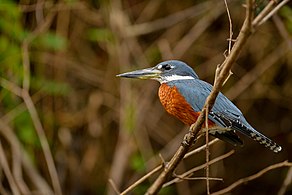
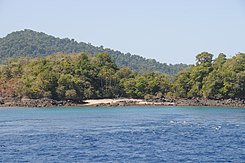
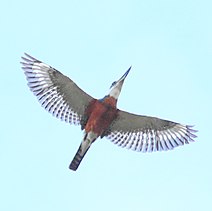
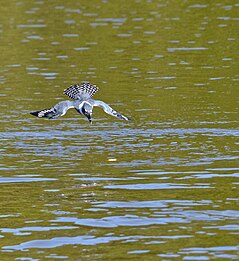
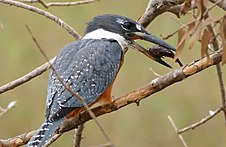
No comments:
Post a Comment
Note: Only a member of this blog may post a comment.